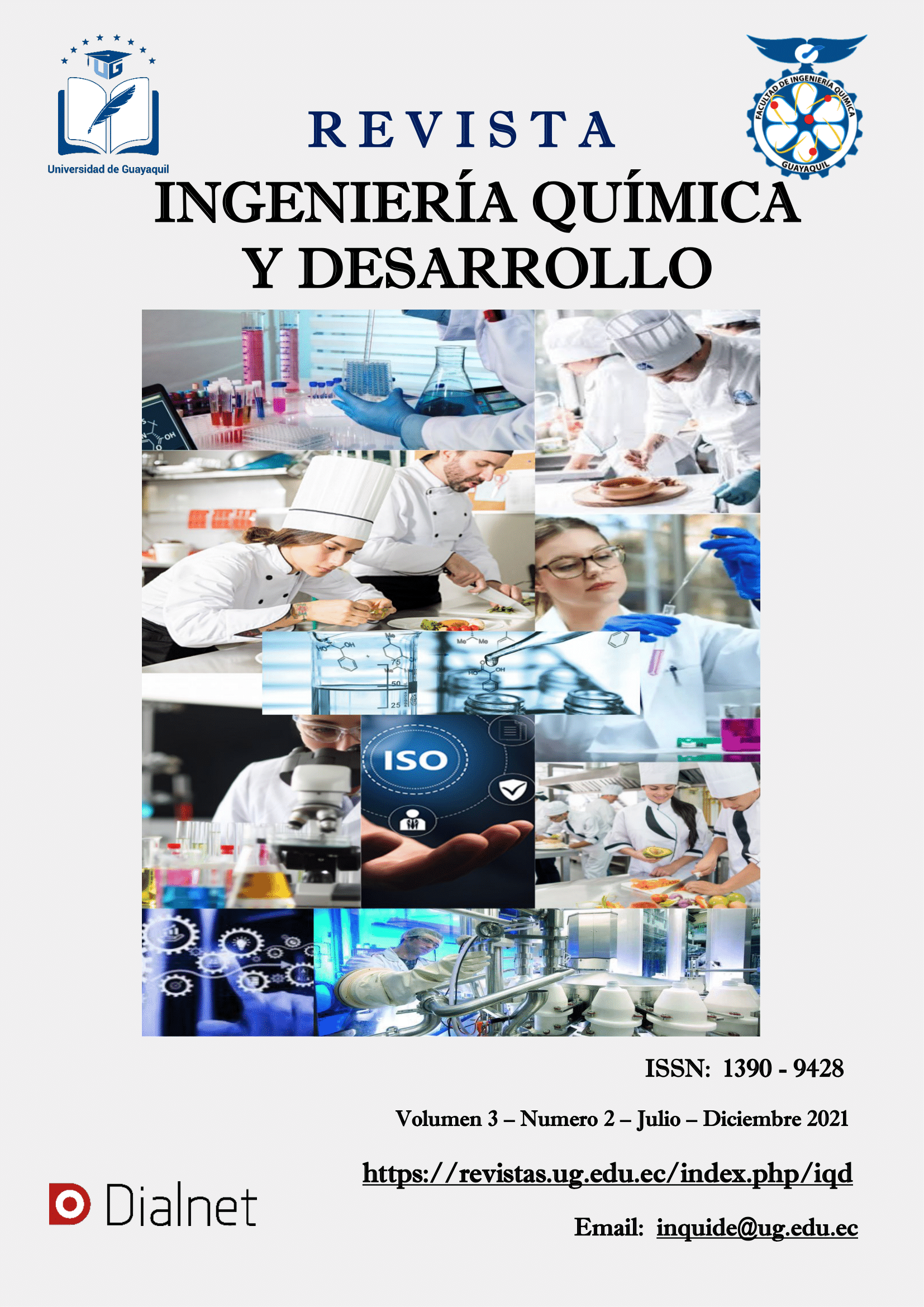Implementation of copper nanoparticles (CuNP) in the composition of a chitosan bioplastic film to compare antimicrobial activity with polyethylene terephthalate (PET)
Main Article Content
Abstract
In this research, NPCu was synthesized to be used in the composition of a bioplastic film of chitosan and to compare the antimicrobial activity of this bioplastic with a commonly used plastic (PET). These nanoparticles were obtained by chemical reaction of copper sulphate with ascorbic acid using microwaves. They were characterized by scanning electron microscopy (SEM) giving an average nanoparticle size of 15nm; the chitosan film enriched with NPCu was subjected to a microbiological study in which the formation of bacterial inhibition halos with a size of 15.5mm and 14.5mm in diameter was observed in the bioplastic samples with E. coli strains and Staphylococcus respectively, whereas in the PET samples it was not possible to visualize inhibition to the bacteria; consolidating with this, the main objective raised in the investigation. In addition, the degradability of the bioplastic was 98% in a period of 8 weeks.
Metrics
Article Details

This work is licensed under a Creative Commons Attribution-NonCommercial-NoDerivatives 4.0 International License.
Esta revista provee acceso libre inmediato a su contenido bajo el principio de que hacer disponible gratuitamente investigación al publico apoya a un mayor intercambio de conocimiento global.
Usted es libre de:
- Compartir — copiar y redistribuir el material en cualquier medio o formato.
Bajo los siguientes términos:
- Atribución — Usted debe dar crédito de manera adecuada, brindar un enlace a la licencia, e indicar si se han realizado cambios. Puede hacerlo en cualquier forma razonable, pero no de forma tal que sugiera que usted o su uso tienen el apoyo de la licenciante.
- NoComercial — Usted no puede hacer uso del material con propósitos comerciales.
- SinDerivadas — Si remezcla, transforma o crea a partir del material, no podrá distribuir el material modificado.
Derechos de autor
Los autores que publican en Ingeniería Química y Desarrollo conocen y aceptan las siguientes condiciones:
- Los autores retienen los derechos de copia (copyright) sobre los trabajos, y ceden a Ingeniería Química y Desarrollo el derecho de la primera publicación del trabajo, bajo licencia internacional Creative Commons Atribución-NoComercial-SinDerivadas 4.0 que permite a terceros compartir la obra siempre que se indique su autor y su primera publicación esta revista.
- Los autores conservan los derechos de autor y garantizan a Ingeniería Química y Desarrollo el derecho de publicar el trabajo a través de los canales que considere adecuados.
- Los autores son libres de compartir, copiar, distribuir, ejecutar y comunicar públicamente la versión del trabajo publicado en Ingeniería Química y Desarrollo, haciendo reconocimiento a su publicación en esta revista.
- Se autoriza a los autores a difundir electrónicamente sus trabajos una vez que sean aceptados para publicación. No se permite el uso comercial de copia o distribución de contenidos, así como tampoco la adaptación, derivación o transformación alguna de estos sin la autorización previa de los autores y de Ingeniería Química y Desarrollo.
References
«Naukas,» 3 Agosto 2018. [En línea]. Available: https://naukas.com/2018/08/03/avances-limites-y-problemas-de-la-nanotecnologia/.
C. C. Carolina, «Biblioteca Universidad de Córdova,» Junio 2011. [En línea]. Available: http://hdl.handle.net/10396/5718.
A. Ávalos Fúnez, A. Haza Duaso y P. Morales Gómez, «Revista Complutense de Ciencias Veterinarias,» Revista Complutense de Ciencias Veterinarias, vol. 10, nº 2, pp. 1-17, 2016.
E. F. Santana, «INVESTIGACIÓN DE FIBRAS DE POLIPROPILENO ADITIVADAS CON NANOPARTÍCULAS DE PLATA PARA LA MEJORA DE PROPIEDADES BIOACTIVAS EN EL SECTOR TEXTIL,» Universidad Politécnica de Valencia, 2011.
M. F. V. Seoane, «Nanotecnología: Su desarrollo en Argentina, sus características y tendencias a nivel mundial,» Universidad Nacional de General Sarmiento, 2011.
D. i. Lab, «Day in Lab,» 10 Agosto 2016. [En línea]. Available: https://dayinlab.com/2016/08/10/sexo-drogas-y-nanotecnologia/.
A. C. O. Alberto Frutos Pérez-Surio, «Nanopartículas de plata en envases de uso alimentario,» Rev. salud ambiente, vol. 15, nº 2, pp. 80-87, 15 Diciembre 2015.
H. Y. López De la Peña, C. M. López, E. M. Múzquiz, F. Hernández y M. Hernández, «Depto. Ciencia y Tecnología de Alimentos, UAAAN,» CienciaAcierta, pp. 1-9, Octubre - Diciembre 2016.
K. Maldonado-Lara, G. Luna-Bárcenas, E. Luna-Hernández, F. Padilla-Vaca, E. Hernández-Sánchez, R. Betancourt-Galindo, J. Menchaca-Arredondo y B. España-Sánchez, «Preparación y Caracterización de Nanocompositos Quitosano-Cobre con Actividad Antibacteriana para aplicaciones en Ingeniería de Tejidos,» Revista Mexicana de Ingeniería Biomédica, vol. 38, nº 1, 2017.
D. A. T. Fica, «SÍNTESIS DE SUSPENSIONES DE NANOPARTÍCULAS DE COBRE Y QUITOSANO, Y EVALUACIÓN DE SUS PROPIEDADES ANTIMICROBIANAS FRENTE A STREPTOCOCCUS MUTANS,» Universidad de chile, Santiago, 2015.
J. M. D. C. G. G. y. E. S. María C. Nápoles, «EFECTO DE DIFERENTES MEDIOS DE CULTIVO EN LA MULTIPLICACIÓN CELULAR DE Bradyrhizobium elkanii,» Revista Cultivos Tropicales, vol. 27, nº 1, pp. 35-38, 2006.
B. C. Carlos y T. T. Junior, «SlideShare,» 31 Marzo 2015. [En línea]. Available: https://es.slideshare.net/CarlosBarahonaChunga/laboratorio-microbiologa.
M. L. Herrera, «Pruebas de sensibilidad antimicrobiana. Métodología de laboratorio,» Revista Médica del Hospital Nacional de Niños Dr. Carlos Sáenz Herrera, vol. 34, Enero 1999.





